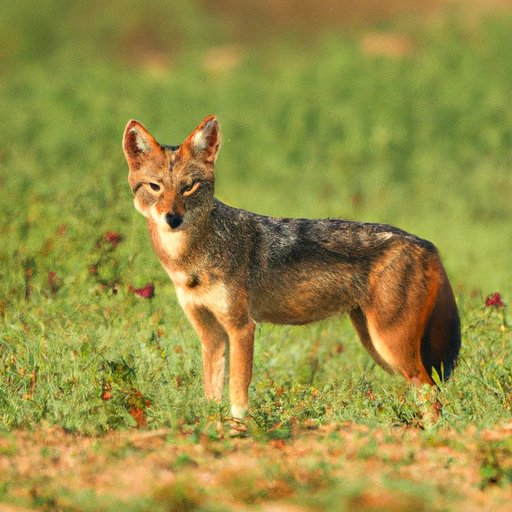Introduction
Have you ever encountered a jackal in the wild or heard their haunting calls at night? These cunning carnivores are often mistaken for their larger and more well-known cousins, the wolves. Understanding jackals and their role in ecosystems is essential, especially when encountering them in the wild. In this article, we will provide a comprehensive guide to jackals, including their physical characteristics, behavior, habitat, adaptation, unique qualities and behaviors, hunting strategies and survival strategies.
The Cunning Carnivore: A Comprehensive Guide on Jackals
Jackals are medium-sized carnivorous mammals belonging to the Canidae family. They are native to Africa, Asia, and southeastern Europe. The three main species of jackal are the golden jackal, black-backed jackal, and side-striped jackal.
Jackals are opportunistic omnivores and foragers. They feed on a wide range of prey, including small mammals, birds, reptiles, insects, and fruits. They are also known to scavenge on carrion and garbage in areas near human settlements.
Jackals are primarily solitary animals, but they can form small packs for hunting or mating. They communicate through a variety of vocalizations, including barks, howls, and yips. They mark their territory through scent marking and can use urine and feces to communicate with other jackals.
Jackals play a vital role in the ecosystem as their predatory behavior helps to control the population of small mammals and insects, which helps to regulate the food chain.
Jackal: The Highly Adaptive Canine Thriving in Different Habitats
Jackals are highly adaptable animals and can thrive in various habitats, from deserts to forests. They are found throughout Africa and the Middle East and as far east as India, China, and southeast Asia. The ability of jackals to survive in different environments is attributed to their adaptive behavior and characteristics.
Golden jackals can live in diverse habitats ranging from desert edges, grasslands, woodland, marshland, river valleys. These jackals are proper travelers and have been known to roam far away from their natal homes. Black or silver-backed jackals (canis mesomelas) tend to thrive in areas with more vegetation, such as savannas like grassy lowlands and bushy highlands, but they can quickly adapt to other types of environments like deserts. Side-striped jackals thrive in habitats with dense vegetation such as thickets, forests, and bush country.
Jackals have adapted to arid and semi-arid environments through their unique physiological and behavioral characteristics. For instance, the golden jackal has adapted to survive in arid environments through its ability to survive on little water and by consuming small prey, which do not require a lot of water to process.
Fascinating Facts about Jackals, the Misunderstood Predators
Jackals are fascinating animals that have unique qualities and behaviors that distinguish them from other carnivores. A common misconception about jackals is that they are only scavengers, but this is not true as they hunt and kill their prey.
One of the most notable features of jackals is their sharp sense of smell, which enables them to detect prey and water sources from a distance. Jackals have been known to communicate with other jackals through their sense of smell by scent-marking their territory.
Another unique characteristic of jackals is their ability to adapt to different environments, which is due to their flexible diet and behavior. For example, the golden jackal is capable of eating a wide range of prey, including small mammals, birds, and fruits, which enables them to thrive in a diverse range of habitats.
An Introduction to the Jackal Family: Their Unique Characteristics and Behaviors
Jackals belong to the Canidae family, which also includes wolves, coyotes, foxes, and domestic dogs. Compared with other members of the family, jackals are relatively smaller, with shorter legs and smaller paws.
Black-backed jackals have a unique characteristic of a “cape of fur,” which runs from the back of their heads all the way down their backs. The side-striped jackal has distinctive stripes running down the side of its body, just as its namesake implies.
Jackals have unique behaviors that distinguish them from other members of the Canidae family. For example, jackals are known to perform a unique vocalization known as “gekkering,” which is used mainly for communication between mating pairs or during confrontations with other jackals.
Surviving the Wild: A Look into the Life of Jackals and their Survival Strategies
Surviving in the wild is not easy, especially for a small carnivore like the jackal. In order to survive, jackals have developed a range of survival strategies that enable them to cope with their environments.
One of the most important survival strategies for jackals is their hunting behavior. Jackals are highly skilled hunters and can use a wide range of hunting techniques to capture their prey. For example, golden jackals hunt cooperatively in groups, while black-backed jackals are known to hunt in pairs or alone.
Another important survival strategy for jackals is their ability to adapt to different environments. By adapting their behavior and diet to suit their surroundings, jackals can survive in a range of different habitats.
Conclusion
Jackals are often misunderstood animals that play a vital role in ecosystems around the world. Understanding their physical characteristics, behavior, habitat, adaptation, unique qualities and behaviors, hunting strategies and survival strategies is essential, especially when venturing into their habitat. As humans continue to encroach on their habitats, it is important that we learn to peacefully coexist with these fascinating animals.
